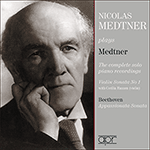
Welcome to Hyperion Records, a British classical label devoted to presenting high-quality recordings of music of all styles and from all periods from the twelfth century to the twenty-first.
Hyperion offers both CDs, and downloads in a number of formats. The site is also available in several languages.
Please use the dropdown buttons to set your preferred options, or use the checkbox to accept the defaults.

Both the brief second movement, Introduzione, and the Finale are headed by quotations from the poem itself: ‘Satan stole away’, ‘And the Angels came’, charting the triumph of righteousness over evil. The malevolent ‘satanic’ theme of the Introduzione is gradually rebuffed as the movement proceeds by fragments of another melody, one that is at last heard in full as the serene second subject of the Finale. One of Medtner’s most beautiful inspirations, this was clearly special for the composer; he used it again in two other works with religious overtones, a setting of Pushkin’s poem The Muse and the Piano Quintet. After a stern fugal episode based on the satanic theme, the music culminates in a joyous restatement of the second theme and the sonata’s opening, against a background of pealing bells.
from notes by Barrie Martyn © 1998
Et le bref second mouvement, «Introduzione», et le finale portent en en-tête des citations du poème même: «Satan s’esquiva», «Et les Anges vinrent», traçant le triomphe de la rectitude sur le mal. Le thème «satanique» malveillant de l’«Introduzione» est repoussé à mesure que le mouvement avance par fragments d’une autre mélodie, qui sera enfin entendue en entier en qualité de second sujet, serein, du finale. Il s’agit là d’une des plus splendides inspirations de Medtner, qui lui accordait un statut bien particulier, puisqu’il la réutilisa dans deux autres œuvres aux accents religieux, savoir une mise en musique du poème de Pouchkine, La Muse, et son Quintette avec piano. Passé un austère épisode fugué fondé sur le thème satanique, la musique culmine en une joyeuse réénonciation du second thème et de l’ouverture de la sonate, sur fond de carillons de cloche.
extrait des notes rédigées par Barrie Martyn © 1998
Français: Hypérion
Sowohl der kurze zweite Satz, „Introduzione“, als auch der Schlußsatz sind mit Zitaten aus dem Gedicht selbst überschrieben: „Satan schlich sich weg“, „Und die Engel kamen“ und zeigt den Triumph der Rechtschaffenheit über das Böse. Das übelwollende „satanische“ Thema der „Introduzione“ wird allmählich zurückgeschlagen, während der Satz seinen Weg mit Bruchstücken einer anderen Melodie fortsetzt, einer, die schließlich als das heitere zweite Thema des Schlußsatzes vollständig zu hören ist. Als eine der schönsten Inspirationen Medtners war sie deutlich etwas Besonderes für den Komponisten; er verwendete sie nochmals in zwei anderen Werken mit religiösem Anstrich—einer Vertonung von Puschkins Gedicht Die Muse und dem Klavierquintett. Nach einem strengen Fugenzwischenspiel, das auf dem satanischen Thema basiert, gipfelt die Musik in einer freudenerfüllten Wiederholung des zweiten Themas und des Sonatenanfangs gegen den Hintergrund läutender Glocken.
aus dem Begleittext von Barrie Martyn © 1998
Deutsch: Anke Vogelhuber
 Medtner: The complete solo piano recordings Medtner: The complete solo piano recordingsAPR’s landmark issue on three CDs of Nicolas Medtner’s complete solo recordings, which included fifteen 78-rpm sides of previously thought lost Columbia recordings from 1931 and an unpublished HMV recording of his Violin Sonata No 1, are here reis ...» More |
 Malcolm Binns - A 90th Birthday Tribute Malcolm Binns - A 90th Birthday TributeMalcolm Binns was for half a century one of the UK’s most significant pianists, giving the UK premiere of Prokofiev’s Piano Concerto No 4 in 1961 to being the first to record the complete Beethoven piano sonatas on original instruments. Here we ha ...» More |

